Last night, after traveling to France from different parts of the United States, the Dominican college presidents and others making the pilgrimage came together for the first time, sharing dinner and conversation, full of anticipation for the week’s experiences. This morning we began with a classroom session, during which we were given an overview of the educational experiences that our Dominican colleges’ faculty, staff, and students who travel each summer to Fanjeaux have as they immerse themselves in learning about the history of the Dominican order. In my first year at Albertus, I heard from numerous faculty and students who made the trip, about how impactful and positive the experience was. I’ve been anxious to learn more ever since. We also spent morning time with prayer, reflections, and an overview of the week’s itinerary. After lunch, we departed to spend the full afternoon in the village of Fanjeaux. Fanjeaux is a small hilltop village that sits about 1,100 feet above sea level, with stunning views of the valleys, farms, and villages below and stretching for miles into the distance. St Dominic arrived in Fanjeaux in 1206. In those first years of Dominic being in Fanjeaux, the area was inhabited by the heretic Cathars. This blog post would never do justice to the significant history of the relationship between the Cathars and Dominic and how the Order of Preachers took shape during his decade or so in the Fanjeaux area, so I won’t try to shorten it for inclusion. What I will address are the highlights of the places we visited while walking through Fanjeaux and wandering down and over the hills to the Prouilhe Monastery.
Fanjeaux is a small hilltop village that sits about 1,100 feet above sea level, with stunning views of the valleys, farms, and villages below and stretching for miles into the distance. St Dominic arrived in Fanjeaux in 1206. In those first years of Dominic being in Fanjeaux, the area was inhabited by the heretic Cathars. This blog post would never do justice to the significant history of the relationship between the Cathars and Dominic and how the Order of Preachers took shape during his decade or so in the Fanjeaux area, so I won’t try to shorten it for inclusion. What I will address are the highlights of the places we visited while walking through Fanjeaux and wandering down and over the hills to the Prouilhe Monastery.
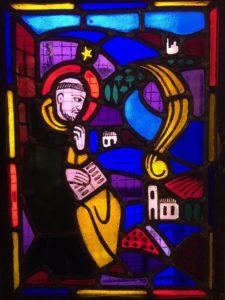 Our first stop in Fanjeaux was to meet and visit with Fr. Renaud Silly, O.P. at “La Maison Saint Dominique.” Fr. Silly warmly welcomed and toured us through the home containing a small room where St. Dominic is believed to have resided for much of his time in Fanjeaux. Walking through a thick wooden door no more than 5 feet high, into St. Dominic’s room was truly a walk back in history. Although the room transformed into a chapel many years ago, it was easy to imagine what it must have been like while occupied by St. Dominic; as Fr. Silly described, it was a place where St. Dominic pondered his loneliness and his calling. The dark wood, tile floors, and fire place are contrasted against the bright stained-glass panels that now cover the one window into the room from the outside. The six stained-glass panels depict important moments in St. Dominic’s life during his time in Fanjeaux. They are beautiful. On a personal note, I experienced a sense of being present and at peace while in the room.
Our first stop in Fanjeaux was to meet and visit with Fr. Renaud Silly, O.P. at “La Maison Saint Dominique.” Fr. Silly warmly welcomed and toured us through the home containing a small room where St. Dominic is believed to have resided for much of his time in Fanjeaux. Walking through a thick wooden door no more than 5 feet high, into St. Dominic’s room was truly a walk back in history. Although the room transformed into a chapel many years ago, it was easy to imagine what it must have been like while occupied by St. Dominic; as Fr. Silly described, it was a place where St. Dominic pondered his loneliness and his calling. The dark wood, tile floors, and fire place are contrasted against the bright stained-glass panels that now cover the one window into the room from the outside. The six stained-glass panels depict important moments in St. Dominic’s life during his time in Fanjeaux. They are beautiful. On a personal note, I experienced a sense of being present and at peace while in the room.
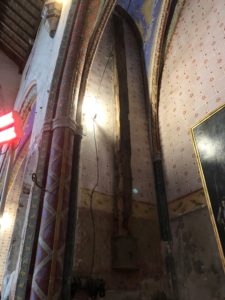
We left the residence and took the few steps to visit “L’Eglise Notre-Dame de l’Assomption.” The current church was built in the late 1270s, early 1280s, more than 50 years after St. Dominic died in 1221. However, the church is built on the same foundation of its predecessor, where St. Dominic preached and served as pastor. Today’s Notre-Dame church is in terrible disrepair, but amid its decay are an array of relics from the time of St. Dominic. The relics are displayed within the church that one easily imagines in its former beauty. Fr. Silly shared so much about Notre Dame’s history and that of the relics it now protects. The church is on France’s list for restoration, which I hope and pray comes to be reality. Among the relics we saw are the “wooden beam” from St. Dominic’s “Fanjeaux Miracle of Fire” experience and 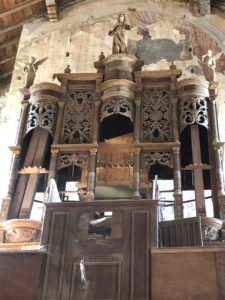 what remains of the oldest church pipe organ in southern France. After listening to Fr. Silly, we left the church and went a few doors down to a smaller chapel that now has as its altar one which was unearthed from the basement of the Notre-Dame church. Fr. Silly indicated the altar has been verified to be the original from the church that stood where Notre-Dame does today, and thus, St. Dominic presided over that altar. We were able to see and touch the altar’s consecration crosses; as I realized the significance of that altar, I was overcome with a feeling of humility and a deepened awareness of my presence, a grace, in that moment in that place.
what remains of the oldest church pipe organ in southern France. After listening to Fr. Silly, we left the church and went a few doors down to a smaller chapel that now has as its altar one which was unearthed from the basement of the Notre-Dame church. Fr. Silly indicated the altar has been verified to be the original from the church that stood where Notre-Dame does today, and thus, St. Dominic presided over that altar. We were able to see and touch the altar’s consecration crosses; as I realized the significance of that altar, I was overcome with a feeling of humility and a deepened awareness of my presence, a grace, in that moment in that place.
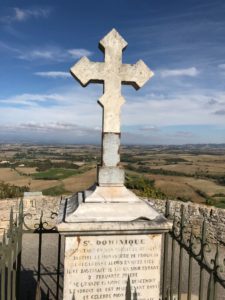 After visiting the churches, we walked to a viewpoint, looking out over the pastoral landscapes that stretch as far as the eye can discern. We also looked down the hills toward the site where St. Dominic saw for three straight nights fire coming down from the sky, pointing him toward Prouilhe, where he would found the convent for his first women followers. Fr. Silly led our group on a long but enjoyable walk down through the winding dirt paths, from the top of Fanjeaux, over hills and through fields that in the late summer are filled with bright yellow sunflowers, to the site of St. Dominic’s fire vision, now marked by a stone cross. The four Dominican presidents
After visiting the churches, we walked to a viewpoint, looking out over the pastoral landscapes that stretch as far as the eye can discern. We also looked down the hills toward the site where St. Dominic saw for three straight nights fire coming down from the sky, pointing him toward Prouilhe, where he would found the convent for his first women followers. Fr. Silly led our group on a long but enjoyable walk down through the winding dirt paths, from the top of Fanjeaux, over hills and through fields that in the late summer are filled with bright yellow sunflowers, to the site of St. Dominic’s fire vision, now marked by a stone cross. The four Dominican presidents 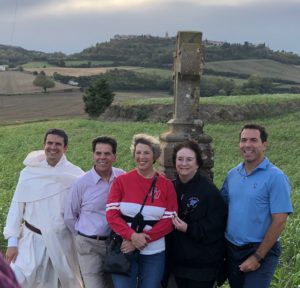 on this pilgrimage joined Fr. Silly for a photo with the cross; Fanjeaux is seen at the top of the hill behind us. (In the picture with me, L to R: Fr. Silly; Dr. Robert Gervasi, president of Ohio Dominican University; Dr. Nancy Blattner, president of Caldwell University; Dr. Donna Carroll, president of Dominican University in Illinois).
on this pilgrimage joined Fr. Silly for a photo with the cross; Fanjeaux is seen at the top of the hill behind us. (In the picture with me, L to R: Fr. Silly; Dr. Robert Gervasi, president of Ohio Dominican University; Dr. Nancy Blattner, president of Caldwell University; Dr. Donna Carroll, president of Dominican University in Illinois).
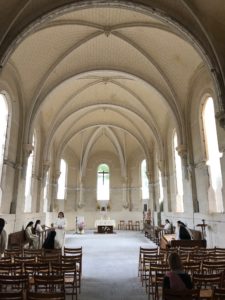 After experiencing the cross, we continued our walk down the hills, taking us to the Prouilhe Monastery. We arrived at the Monastery just in time for the nuns’ evening Vespers, which was held in the Choir of the Basilica on the grounds of the Monastery. The voices of the nuns were beautiful and illuminating, but at the same time grounding and a reminder of their lives’ calling. The Choir is in disrepair and the Basilica itself was never finished. We learned about the saddened state of the Monastery facilities, including a guest house that now is shuddered. Seeing these sacred spaces in such disrepair, along with the Fanjeaux churches, left me with feelings of sorrow and anger.
After experiencing the cross, we continued our walk down the hills, taking us to the Prouilhe Monastery. We arrived at the Monastery just in time for the nuns’ evening Vespers, which was held in the Choir of the Basilica on the grounds of the Monastery. The voices of the nuns were beautiful and illuminating, but at the same time grounding and a reminder of their lives’ calling. The Choir is in disrepair and the Basilica itself was never finished. We learned about the saddened state of the Monastery facilities, including a guest house that now is shuddered. Seeing these sacred spaces in such disrepair, along with the Fanjeaux churches, left me with feelings of sorrow and anger.
I was uplifted, however, with a visit to the gift shop run by the nuns; walking through its few aisles and observing the books and handmade merchandise, including some made by the nuns themselves, helped remind me of the need to seek and focus on the good and the positive versus the bad and the negative. Among the many lessons and learnings of my day.
After our visit to the Monastery, we boarded our bus for the return trip to our hotel. It’s now time for a group dinner, and then sleep beckons as I’ll look forward to the promise of what tomorrow will bring when we visit Carcassone and the Basilica of St. Nazaire.
President Marc M. Camille, Ed.D., will write regular reflections during his week-long pilgrimage to Fanjeaux, France, with other Dominican college presidents. Fanjeaux is the area where, eight centuries ago, the Dominican Order was founded by Dominic de Guzmán, or St. Dominic as he is known today. This pilgrimage is a unique opportunity to visit and experience a number of the historical sites where St. Dominic spent considerable time leading up to and after the founding of the Order.
